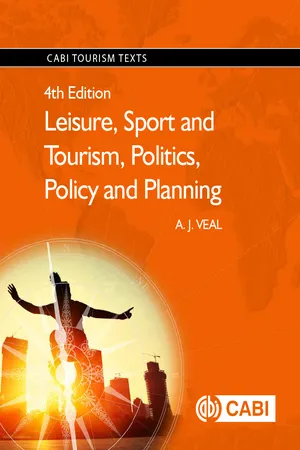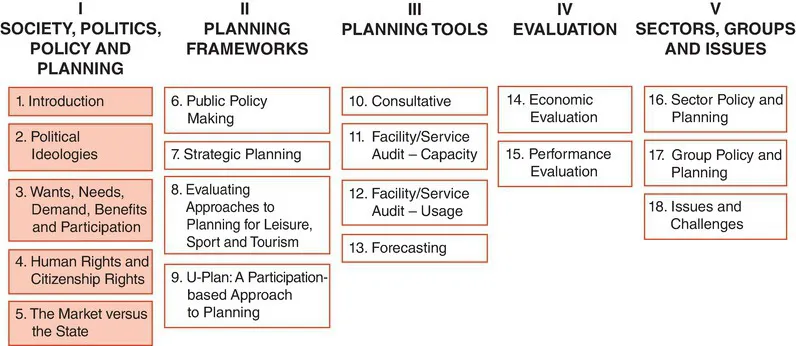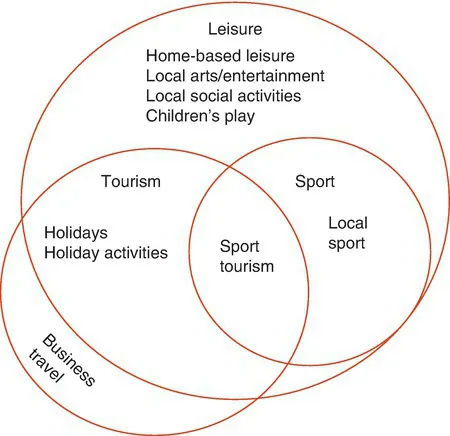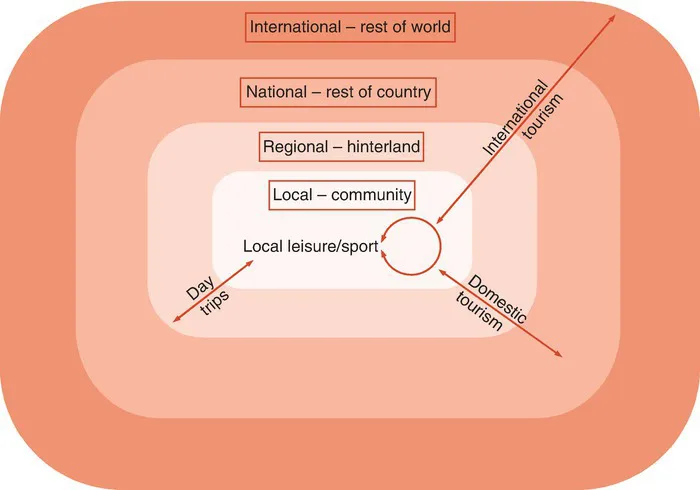![]()
PART I
Society, Politics, Policy and Planning
![]()
chapter 1
Introduction
Introduction
Defining Leisure, Sport and Tourism
Governments and Leisure, Sport and Tourism
Framework
Perspective
Content and Structure of the Book
Summary
Resources
References
INTRODUCTION
This book is concerned with the activities of policy making and planning as carried out by governments and associated agencies in the field of leisure, sport and tourism. Governments are distinguished from organizations in the private/commercial and voluntary/not-for-profit sectors by their, generally, democratic nature, which makes them accountable to the public at large. They also exercise considerable power over citizens and other institutions, within a framework of law. Government, together with a plethora of appointed and elected agencies and an independent judiciary, is referred to as the state or the public sector. It is hard to think of any type of leisure, sport or tourism facility or service that is not provided by public, commercial and not-for-profit organizations. For example:
1. golf courses and gyms are provided by local councils, by commercial companies and by not-for-profit clubs;
2. theatres are owned and operated by governments at all levels, by commercial organizations and by not-for-profit trusts; and
3. tourist attractions, such as heritage sites, are owned and managed by all three sectors.
In a number of Western countries, the distinction between the public and non-public sectors has, however, become less clear in many fields in recent years as more services traditionally provided by public bodies have been sold off, leased or contracted out to private and not-for-profit operators or developed in public–private partnerships. Such arrangements have, however, been commonplace in the field of leisure, sport and tourism for many years. Public bodies have for a long time contracted various leisure, sport and tourism functions to commercial and non-profit organizations, including the operation of hospitality outlets and seasonal swimming pools, and have leased out buildings, such as theatres and heritage sites, sometimes on a commercial basis and sometimes for a ‘peppercorn’ rent to not-for-profit bodies. Many commercial and not-for-profit organizations in sport, tourism, entertainment and the arts make use of public buildings and lands. It is clear that there has always been a mixed economy of leisure, sport and tourism. However, the scale of change in recent decades has been substantial, bringing a marked shift away from direct public sector management and giving rise to much soul-searching as to the appropriate ‘mix’ of the public and private sectors.
DEFINING LEISURE, SPORT AND TOURISM
In the book, leisure, sport and tourism are sometimes referred to separately and sometimes together. Each of these is a form of human non-work activity, but also an industry and an area of government policy. Each has been subject to continuing debate over the question of definition, but for the purposes of this book we adopt three relatively simple definitions from the many available:
• Leisure is ‘relatively freely undertaken non-work activity’ (Roberts, 1978, p. 3).
• Sport is ‘a recreational activity requiring bodily exertion and carried on according to a set of rules’ (Oxford Pocket English Dictionary).
• Tourism is ‘the temporary movement of people to destinations outside their normal places of work and residence’ (Mathieson and Wall, 1982, p. 1).
Thus the three phenomena overlap, as suggested in Fig. 1.1. Sport is entirely a form of leisure, except for the relatively small number of professional sports people. In the case of tourism, travel for non-leisure purposes is often included, for example business and conference travel – but even these people generally make use of leisure facilities at their destination, often mixing business and pleasure. The industries associated with these phenomena provide many people with jobs, not only in management and service support, but also in engaging professionally in activities which they see as work – for example, professional artists and sports people – but which, when engaged in by the rest of us on an unpaid basis, are seen as leisure.
The overlaps and relationships can also be viewed in spatial terms, as illustrated in Fig. 1.2. While leisure and sporting facilities are generally planned primarily to meet the needs of the residents of the local communities in which they are located, many cater for both tourists and locals. Thus the patrons of a restaurant or the visitors to a museum, a beach or a sports stadium can be a mixture of local residents and tourists. The overlap can also be seen in the phenomenon of the day-tripper or excursionist who does not stay overnight in a destination, and is therefore excluded from many definitions of tourism, but who clearly acts like, and has many of the same demands as, the tourist. This intermingling of locals and tourists may not apply in some situations, or may only apply to a limited extent, typically where the bulk of local residents are much poorer than the tourists and/or when facilities for tourists are deliberately planned in relatively high-priced enclaves.
The geography of leisure, sport and tourism results in five different planning environments that we are mindful of throughout the book, as illustrated in Fig. 1.3.
1. Single site: eventually, all planning culminates in consideration of single sites or facilities, such as a single park or stadium. In this book we are mostly concerned with the other four scenarios shown in the diagram, reflecting the principle that any one facility should be planned within a strategic context, taking account of other similar and/or competing facilities. Major facilities are invariably subject to more detailed individual study, often referred to as a feasibility study and much relevant research, particularly in relation to natural areas, has arisen from single-site planning contexts, where the policy focus is on internal management of the site rather than consideration of the strategic context, although there has been some discussion of the limitations of such an approach in the literature (Driver, 2008).
2. Urban planning environment: the residential population is distributed throughout the planning area, as are leisure, sport or tourism facilities.
3. Urban–rural region type A: the major population centre and a number of lesser population centres are located inside an otherwise rural or semi-rural planning area.
4. Urban–rural region type B: the major population centre is located outside the planning area and so a major source of demand is in the form of day-trippers into the area.
5. Tourism destination: the major focus is on visitors who arrive from outside the region via access points like airports or major highways. This can also be an additional feature of any of the other three environments.
GOVERNMENTS AND LEISURE, SPORT AND TOURISM
Range
Despite the importance of the commercial and not-for-profit sectors, substantial parts of the leisure industries nevertheless continue to lie wholly or substantially within the public domain, including:
1. urban and national parks;
2. sports facilities and events;
3. arts facilities, organizations and events;
4. public broadcasting;
5. natural and cultural heritage; and
6. tourism promotion.
Even when management of publicly owned facilities has been handed over to the private or voluntary sector, the public agency generally retains overall responsibility. Local councils and provincial governments in particular have a wide-ranging responsibility and concern for the economic vitality of their local economies and for the overall quality of life of members of their communities. This involves a broad concern for the availability and quality of leisure services and facilities generally and for tourism as a sector of economic activity, in addition to such matters as jobs, schools, roads, drains and refuse collection.
In Western-style liberal democracies, governments provide and administer the law, which limits or controls individual and collective behaviour, but they are also involved in the economic activity of delivering goods and services. While most economic activity takes place in the non-government sector, at least 25% is typically accounted for by governments. The range and types of government activity is indicated in general terms in Table 1.1. At one extreme, activities such as sport and the arts are promoted, via subsidy or direct provision of facilities, while at the other extreme some activities are prohibited, for example, the use of certain recreational drugs and cruel sports. Between these extremes, legislation and taxation are used to support or regulate leisure activities in various ways.
Table 1.1. The range of government involvement in leisure, sport and tourism.
| Sector | Types of government involvement |
| P... |




